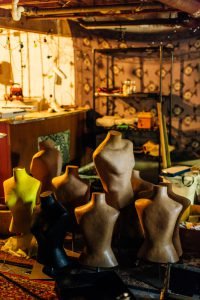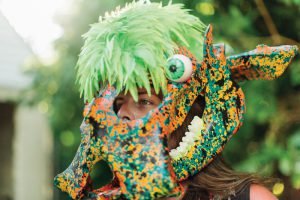+ By Theresa C. Sanchez + Photography By Allison Zaucha
Symbolism runs just as deep as the land is high on Presidents Hill, if you know where to look. Just before you hit Westgate Circle, at the edge of the Annapolis Arts District, nestled at the end of Jefferson Place sits a yellow and green metal crab. Standing about two feet high, it greets visitors at the front of the quaint 20th-century home’s brick and flagstone portico steps.
 It’s fitting that the welcome sign features a crustacean, given that the blue species of decapod is not only one of the official state symbols, but also Maryland’s state food. The surrounding land was once Brewer’s orchard, which was the historic city’s major supplier of apple cider vinegar—an ingredient used to accentuate the taste of the aforementioned seafood’s tender meat. Diners appreciate what it takes to procure the tasty treat from its thick outer armor; that process often makes its consumption a social occasion. The crab’s deceivingly hard shell can be likened to the house’s dull ecru-colored stucco exterior—both have something worth finding inside, if you’re willing to put forth the effort.
It’s fitting that the welcome sign features a crustacean, given that the blue species of decapod is not only one of the official state symbols, but also Maryland’s state food. The surrounding land was once Brewer’s orchard, which was the historic city’s major supplier of apple cider vinegar—an ingredient used to accentuate the taste of the aforementioned seafood’s tender meat. Diners appreciate what it takes to procure the tasty treat from its thick outer armor; that process often makes its consumption a social occasion. The crab’s deceivingly hard shell can be likened to the house’s dull ecru-colored stucco exterior—both have something worth finding inside, if you’re willing to put forth the effort.
Rust-Oleum® cans cleverly strewn across a round wrought iron and glass table, a makeshift sculpture made of a partial cow skull, a piece of multibranched driftwood, and a conch shell horn provide additional clues as to what, and who, might exist behind door No. 39. Suspicions prove to be well founded.
Rabbit holes and looking glasses have nothing on what sights there are to behold upon crossing the humble threshold into the 1,525 square-foot 4-bedroom bungalow, built in 1946. The wealth of purposefully arranged antiques, artifacts, and oddities ornamenting the iris mauve-colored walls evokes ocular overload. Deciding on which item to examine first is truly a daunting undertaking.
Bordering the perimeter of the living room are three reclaimed earth-colored Naugahyde® sofas, all of which face each other, encouraging conversational exchange among its varied occupants. This tête-à-tête might concern the fabled backstories of each of the varied items adorning the room. The most prominent objet d’art hangs above one of the couches. It is a traditional hand-painted decorative Asian fan over four feet in width.
The eyes then dart over to the many sculptures of skulls—bovine, wildebeest, raccoon, and squirrel—splattered with ultra-violet light-reactive psychedelic paint that might please the likes of celebrated artists Georgia O’Keefe and Salvador Dali. Striped falsa Mexican blankets serve as window treatments that keep daylight at bay. They also obstruct the property’s waterfront view, which exists in the form of a standpipe erected in 1928 as part of the city’s water system.
 Dozens of plants of varying shape, size, and genus festoon the windowsills providing a wealth of oxygen-rich air in what could be an otherwise stuffy situation given the room’s size and daily foot traffic. The largest flora is an invasive species affectionately called “Mother Tron,” which shoots out seeds at such an alarming rate that the saplings are potted and distributed as parting gifts to visitors. A vintage large Technics® stereo system, capable of both analog and digital playback, serves as an additional sound system to the large flat-screen television speakers.
Dozens of plants of varying shape, size, and genus festoon the windowsills providing a wealth of oxygen-rich air in what could be an otherwise stuffy situation given the room’s size and daily foot traffic. The largest flora is an invasive species affectionately called “Mother Tron,” which shoots out seeds at such an alarming rate that the saplings are potted and distributed as parting gifts to visitors. A vintage large Technics® stereo system, capable of both analog and digital playback, serves as an additional sound system to the large flat-screen television speakers.
If the senses are somehow still deprived of stimulation, guests may gather in the basement area known for its legendary nightclub-like atmosphere and performances. Steps lead down to a cavernous wonderland that, when in full operation, boasts a professional lighting system, smoke machines, a designated lounge area, and a stage complete with an entire band’s instrumental setup.
A secluded respite from the raucous subterranean recreation taking place on the lowest level of the residence exists at the top of a curved staircase. The archway over the timber steps is accented with ornate African masks. A window overlooking the overgrown backyard provides backlight to a glass display case featuring what can only be described as one-of-a-kind skeletons, whimsically articulated and embellished by one of the home’s inhabitants, who sells the sculptures as artwork. Upon closer examination, one might spy a clear orb filled with sheep’s eyeballs. A new wall was constructed to section off an additional bedroom and seating area for comfort and contemplation. Original psychedelic paintings and kaleidoscopic tapestries enhance the overall experience.
“I’m just trying to give them a new life in a sense, you know? It’s all found,” says SweetWells of the items adorning the abode. “Basically, I’m taking something that was sitting there and withering away and forgotten about, and transforming something that is dead and mak[ing] it look wild and alive again.”
Before leaving this bohemian menagerie, you must first open the front door, emblazoned with a black and white vortex-like hypno spiral. Even though reality awaits outside, those in need of a shift in perspective can always return with a simple knock. █




























































